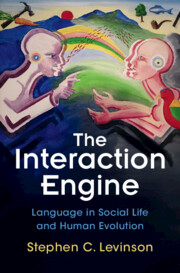Refine search
Actions for selected content:
283 results
3 - Law and the Interaction between International Organizations
-
-
- Book:
- International Organizations Engaging the World
- Published online:
- 09 October 2025
- Print publication:
- 23 October 2025, pp 44-60
-
- Chapter
-
- You have access
- Open access
- HTML
- Export citation
3 - The category of polynomial functors
- from Part I - The category of polynomial functors
-
- Book:
- Polynomial Functors
- Published online:
- 27 September 2025
- Print publication:
- 16 October 2025, pp 51-104
-
- Chapter
- Export citation
The Impact of L1 Speaking Style, Task Mode, and L2 Proficiency on L2 Fluency: A Within-subject Study of Monologic and Dialogic Speech
-
- Journal:
- Studies in Second Language Acquisition , First View
- Published online by Cambridge University Press:
- 08 October 2025, pp. 1-21
-
- Article
-
- You have access
- Open access
- HTML
- Export citation
Mixed-state branching evolution for cell division models
- Part of
-
- Journal:
- Journal of Applied Probability , First View
- Published online by Cambridge University Press:
- 29 September 2025, pp. 1-22
-
- Article
- Export citation

Polynomial Functors
- A Mathematical Theory of Interaction
-
- Published online:
- 27 September 2025
- Print publication:
- 16 October 2025
5 - Interaction
-
- Book:
- Applying Corpus Linguistics to Illness and Healthcare
- Published online:
- 05 September 2025
- Print publication:
- 25 September 2025, pp 68-84
-
- Chapter
-
- You have access
- Open access
- HTML
- Export citation
Interaction does not lead to spontaneous category-based conditioning in an artificial language
-
- Journal:
- Language and Cognition / Volume 17 / 2025
- Published online by Cambridge University Press:
- 19 September 2025, e74
-
- Article
-
- You have access
- Open access
- HTML
- Export citation

Applying Corpus Linguistics to Illness and Healthcare
-
- Published online:
- 05 September 2025
- Print publication:
- 25 September 2025
-
- Book
-
- You have access
- Open access
- Export citation
Fuck syntax and fucking syntax in the borrowing of swearwords for assessments in Danish
-
- Journal:
- Nordic Journal of Linguistics / Volume 48 / Issue 2 / October 2025
- Published online by Cambridge University Press:
- 11 August 2025, pp. 164-188
-
- Article
-
- You have access
- Open access
- HTML
- Export citation
From ritual spaces to monumental expressions: rethinking East Polynesian ritual practices
-
- Article
-
- You have access
- Open access
- HTML
- Export citation
The Interaction Between the Competition Council and the Telecommunications Regulatory Authority in Algerian Law
-
- Journal:
- Journal of African Law / Volume 69 / Issue 3 / October 2025
- Published online by Cambridge University Press:
- 07 July 2025, pp. 333-346
- Print publication:
- October 2025
-
- Article
-
- You have access
- Open access
- HTML
- Export citation
23 - Task-Based Language Teaching
- from Part V - Practice
-
-
- Book:
- The Cambridge Handbook of Technology in Language Teaching and Learning
- Published online:
- 15 June 2025
- Print publication:
- 26 June 2025, pp 377-392
-
- Chapter
- Export citation
Interaction of pyroxasulfone and encapsulated saflufenacil applied preemergence to corn
-
- Journal:
- Weed Technology / Volume 39 / 2025
- Published online by Cambridge University Press:
- 02 June 2025, e84
-
- Article
-
- You have access
- Open access
- HTML
- Export citation
Gateway to the east: the Palaspata temple and the south-eastern expansion of the Tiwanaku state
-
- Article
-
- You have access
- Open access
- HTML
- Export citation
The relief of El Cerrón: insights into central Iberian elite identity in the Late Iron Age
-
- Article
-
- You have access
- Open access
- HTML
- Export citation

The Interaction Engine
- Language in Social Life and Human Evolution
-
- Published online:
- 16 May 2025
- Print publication:
- 19 June 2025
-
- Book
-
- You have access
- Open access
- Export citation
3 - What Are the Roles of Input and Output?
-
- Book:
- Key Questions in Second Language Acquisition
- Published online:
- 11 April 2025
- Print publication:
- 17 April 2025, pp 45-66
-
- Chapter
- Export citation
Understanding the sepiolite–indigo interaction and its effect on Maya blue pigment by alkali pre-treatment of sepiolite
-
- Journal:
- Clays and Clay Minerals / Volume 73 / 2025
- Published online by Cambridge University Press:
- 14 March 2025, e13
-
- Article
- Export citation
5 - Comprehensive Deterrence Theory: Principles
-
- Book:
- Comprehensive Deterrence Theory
- Published online:
- 06 March 2025
- Print publication:
- 13 March 2025, pp 107-148
-
- Chapter
- Export citation
4 - Comprehensive Deterrence Theory: Intrinsic Elements
-
- Book:
- Comprehensive Deterrence Theory
- Published online:
- 06 March 2025
- Print publication:
- 13 March 2025, pp 69-106
-
- Chapter
- Export citation

